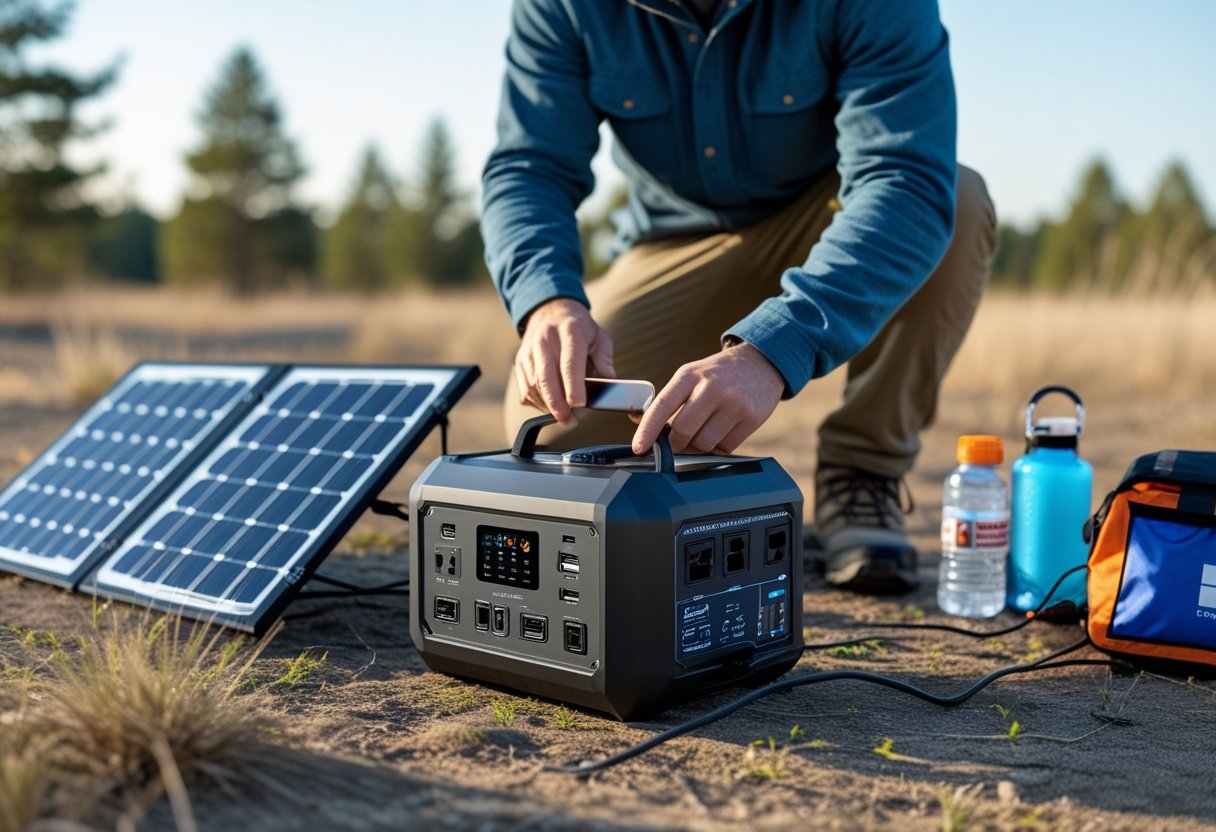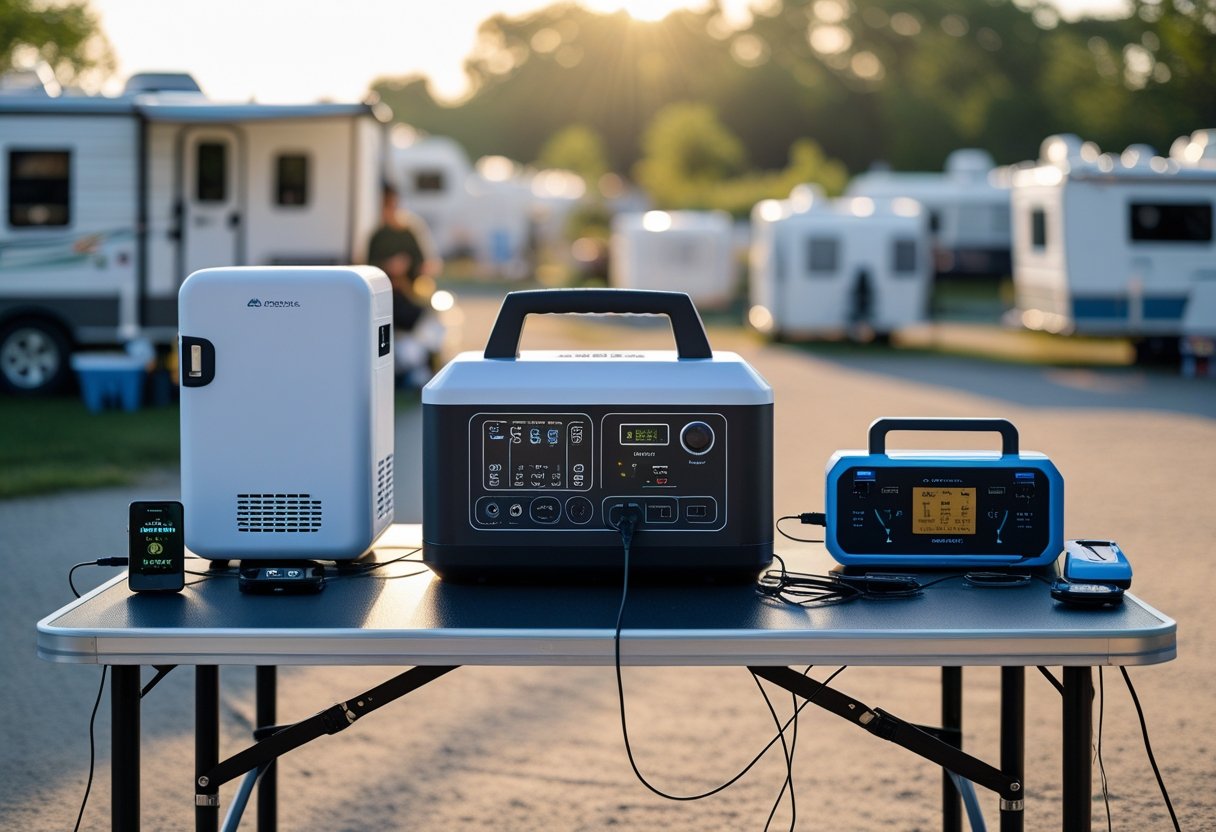A solar generator provides a reliable and quiet power source during emergencies when traditional electricity is unavailable. It works by converting sunlight into electrical energy, which can then be used to charge devices or run essential equipment. Using one effectively ensures continuous power for communication, lighting, and small appliances.

Knowing how to set up and operate a solar generator can make a significant difference when the power goes out. Users should position solar panels for maximum sun exposure, connect the generator to devices carefully, and monitor power consumption to extend battery life. Proper use helps maintain critical functions without relying on fuel or noise-producing alternatives.
Understanding these practical steps allows people to confidently use solar generators in various emergency scenarios. This knowledge offers peace of mind, knowing they have a sustainable backup energy option at hand. For more details on using solar generators in emergencies, see this guide on portable solar generators.
Essential Steps for Using a Solar Generator in Emergencies
When using a solar generator in an emergency, it is crucial to carefully evaluate power requirements, properly set up the solar panels, and connect the system correctly to ensure safe and efficient operation. Addressing these steps systematically maximizes the usability of a portable solar generator during power outages.
Assessing Your Power Needs
Before deploying a solar generator, determine which devices require power and their energy consumption in watts. Prioritize essential appliances such as medical devices, communication tools, and lighting.
Create a list with estimated run times and total watt-hours needed. This allows selecting a solar generator with adequate battery capacity and inverter output. Overloading the generator can reduce efficiency or cause shutdowns.
Consider both continuous and peak power demands, particularly for high-startup load appliances like refrigerators or pumps. Knowing exact power needs helps avoid unnecessary energy waste during emergencies.
Setting Up Portable Solar Panels
Position the portable solar panels in a location with maximum sun exposure, ideally facing south in the northern hemisphere. Avoid shading from trees, buildings, or debris that could reduce energy generation.
Use adjustable mounts or stands to tilt panels at the optimal angle based on the season, improving energy absorption. Secure cables from the panels to the generator, keeping connections tight and protected from moisture.
Portable solar panels must be regularly cleaned to maintain efficiency, especially after storms or heavy dust. Following manufacturer guidelines ensures panels convert sunlight to electricity reliably during outages.
Connecting and Operating the Solar Generator
Connect the solar panels to the solar generator using the correct input ports and cables, ensuring polarity matches to prevent damage. Many generators have integrated charge controllers that regulate panel output and prevent overcharging.
Power the generator fully before emergency use, then monitor battery levels during operation to avoid unexpected shutdowns. Connect appliances via AC or DC outputs depending on their requirements.
Turn on the generator following manufacturer instructions. Use only approved extension cords and avoid overloading outlets. Regularly check for warning indicators or unusual noises that could signal faults.
Efficient and safe operation extends battery life and ensures continuous emergency power when it is most needed. For more detailed guidance, see portable solar generator setup advice.
Critical Devices and Appliances to Power

Prioritizing which devices to power during an emergency ensures essential functions continue smoothly. Focus on medical electronics and key home appliances that maintain safety, comfort, and health.
Essential Electronics and Medical Devices
Medical equipment like CPAP machines and oxygen concentrators must have reliable power. These devices often depend on continuous electricity to operate and cannot tolerate interruptions during power outages.
Portable solar generators with sufficient capacity can safely power these devices, but users should verify wattage requirements beforehand. For instance, many CPAP machines consume between 30-60 watts, while oxygen concentrators may require higher sustained power.
Uninterruptible power supplies (UPS) can bridge the gap during outages, protecting devices from sudden shutdowns. An inverter is often necessary to convert stored DC power to AC for medical electronics. Maintaining power to communication devices—phones, radios, or modems—is also critical to receive emergency updates.
Refrigerators, Water Heaters, and Home Essentials
Keeping a refrigerator running prevents food spoilage during extended outages. Modern energy-efficient models usually require 100-200 watts at startup, but steady operation often needs less. The solar generator should support this initial surge.
A water heater can be powered depending on its size; however, many require significant energy and might exceed portable solar generators’ capacity. Smaller or tankless electric water heaters may be viable alternatives but require assessment before use.
Home essentials like fans or LED lights consume less power and can extend comfort. Prioritizing devices based on wattage and runtime helps optimize energy use during emergencies, ensuring the solar generator supports critical systems without overload.
For practical advice on setting up suitable capacity, see portable solar generators for emergencies.
Comparing Solar Generators to Gas Generators in Emergencies
Solar generators and gas generators differ significantly in terms of safety and maintenance needs. Understanding these differences is crucial for selecting the right emergency power source based on risk, convenience, and resource availability.
Safety Considerations and Carbon Monoxide Risks
Gas generators emit exhaust gases that include carbon monoxide, a hazardous and potentially fatal gas. Proper ventilation is essential when operating gas generators indoors or in enclosed spaces to prevent carbon monoxide poisoning. This risk makes gas generators less safe for indoor use or poorly ventilated areas.
Solar generators use solar power and produce no emissions during operation. They pose no risk of carbon monoxide poisoning, making them safer for indoor and outdoor emergency use. Brands like Goal Zero specialize in portable solar solutions designed with user safety in mind, eliminating the need for ventilation.
Users must carefully consider the environment where the generator will be used to avoid health hazards linked to gas generators.
Fuel and Maintenance Differences
Gas generators require a steady supply of fuel such as natural gas, propane, or gasoline. Fuel storage can be challenging during emergencies due to availability and shelf life concerns. Gas generators also need regular maintenance, including oil changes, spark plug checks, and fuel system upkeep to ensure reliability.
In contrast, solar generators rely primarily on solar panels to recharge batteries. This eliminates ongoing fuel costs and the risks related to fuel storage. Maintenance is minimal, usually involving battery upkeep and panel cleaning.
| Aspect | Gas Generators | Solar Generators |
|---|---|---|
| Fuel | Gasoline, natural gas, propane | Solar power (free & renewable) |
| Fuel Storage | Necessary, limited shelf life | Not required |
| Maintenance | Regular (oil, spark plugs) | Minimal (battery, cleaning) |
| Operation Duration | Limited by fuel availability | Limited by battery capacity and sunlight |
Choosing between these types depends on factors like fuel access, maintenance ability, and safety preferences. For quick and safe setup, solar generators provide clear advantages in emergencies (source).
Maximizing Efficiency and Storage
Effective use of a solar generator depends heavily on managing battery health, optimizing energy reserves during long outages, and properly integrating power electronics. These steps help maintain power availability and extend the lifespan of key components under various conditions like boondocking or emergency use in an Airstream.
Battery Capacity and Lithium Battery Care
Battery capacity dictates how long a solar generator can provide power. Lithium batteries are preferred for their high energy density and longer cycle life compared to lead-acid batteries. To preserve lithium battery health, it is crucial to avoid deep discharges below 20% and limit charging above 80% when storing the generator for extended periods.
Temperature impacts lithium battery efficiency, so operating and storing in moderate temperatures helps prevent capacity loss. Regularly maintaining battery charge between 50% and 80% during storage prevents degradation. Many systems, including popular units like Jackery, have built-in battery management systems to prevent overcharging and excessive discharge.
Energy Storage Strategies for Extended Power Outages
During prolonged outages, conserving stored energy is critical. Users should prioritize powering essential devices and avoid running high-draw equipment simultaneously. Breaking loads into smaller segments helps extend battery runtime.
Recharging the battery efficiently requires proper solar panel positioning for maximum sunlight exposure. Cloudy or shaded conditions reduce charge rates, making backup sources like gensets useful if solar input is insufficient. Rotating between solar input and controlled generator charging maximizes battery preservation and maintains a sustainable power supply.
Integrating with Inverters and Converter Chargers
Inverters convert DC power from batteries into AC power for common household devices. Selecting an inverter rated for at least 20-30% above peak load protects against overload failures. Pure sine wave inverters ensure stable power, compatible with sensitive electronics.
Converter chargers manage charging between multiple power sources, such as solar panels, power grid, or a genset. This integration allows seamless transition between charging modes. For example, in remote locations like an Airstream campsite, the converter charger enables efficient recharging from solar panels during the day and a genset at night.
Proper integration reduces energy loss, safeguards batteries, and ensures consistent power availability under varying conditions.
Top Pick: Jackery Explorer 1000
Reliable, portable, and powerful — ideal for blackouts, camping, and off-grid living.
Check Price on Amazon →